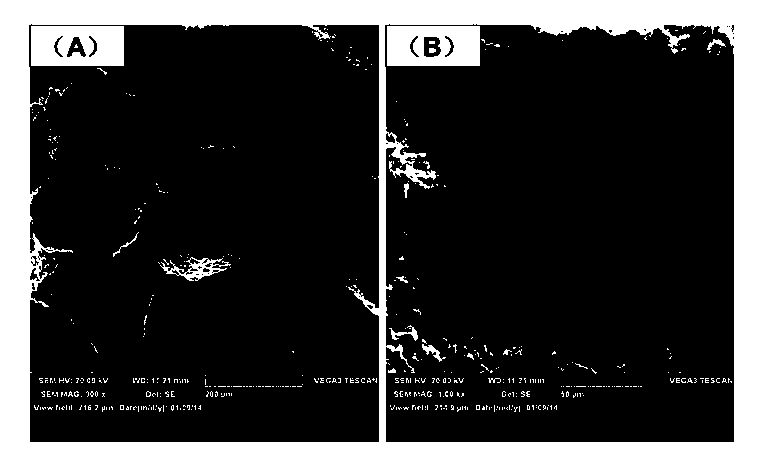3D (three-dimensional) uniform porous scaffold material and preparing method thereof
A porous scaffold, uniform technology, applied in the field of biomedical materials, can solve the problems of affecting cell adhesion, high pore size, affecting cell migration and proliferation, etc.
- Summary
- Abstract
- Description
- Claims
- Application Information
AI Technical Summary
Problems solved by technology
Method used
Image
Examples
preparation example Construction
[0032] A method for preparing a 3D uniform porous scaffold material, characterized in that:
[0033] Achieved by the following steps:
[0034] Step 1: Dissolving collagen in sodium carbonate solution so that the final mass fraction of collagen reaches 10-30%;
[0035] Step 2: Add nano-hydroxyapatite to the mixture in step 1, the mass ratio of collagen to nano-hydroxyapatite is 1: (3-5), shake on the vortex mixer until the mixture is uniform, and the viscosity is uniform like emulsion;
[0036] Step 3: distributing the mixture obtained in step 2 into moulds;
[0037] Step 4: The mold is frozen at -80°C for 3-6 hours, and then vacuum-dried for 48 hours;
[0038] Step 5: carry out the cross-linking reaction of the primary freeze-dried product in step 4 in an excess of cross-linking agent solution, 100ml of cross-linking agent solution corresponds to 12-15g of the primary freeze-dried bone scaffold material, the pH of the cross-linking system is 8-11, The reaction temperature ...
Embodiment 1
[0050] Step 1: dissolving collagen in sodium carbonate solution so that the final mass fraction of collagen reaches 10%;
[0051] Step 2: Add nano-hydroxyapatite to the mixture in step 1. The mass ratio of collagen to nano-hydroxyapatite is 1:3. Shake on a vortex mixer until evenly mixed to obtain a viscous and uniform emulsion ;
[0052] Step 3: distributing the mixture obtained in step 2 into moulds;
[0053] Step 4: The mold is frozen at -80°C for 3 hours, and then vacuum-dried for 48 hours;
[0054] Step 5: Carry out the cross-linking reaction of the primary freeze-dried product in step 4 in an excess of cross-linking agent solution, 100ml of cross-linking agent solution corresponds to 12g of the primary freeze-dried bone scaffold material, the pH of the cross-linking system is 8, and the reaction temperature is 37 °C, the reaction time is 24h;
[0055] Step 6: Perform a secondary cross-linking reaction on the sample cross-linked in step 5 in an excess of cross-linking ...
Embodiment 2
[0066] Step 1: dissolving collagen in sodium carbonate solution so that the final mass fraction of collagen reaches 20%;
[0067] Step 2: Add nano-hydroxyapatite to the mixture in step 1. The mass ratio of collagen to nano-hydroxyapatite is 1:4. Shake on a vortex mixer until evenly mixed to obtain a viscous and uniform emulsion ;
[0068] Step 3: distributing the mixture obtained in step 2 into moulds;
[0069] Step 4: The mold is frozen at -80°C for 4.5 hours, and then vacuum-dried for 48 hours;
[0070] Step 5: Carry out the cross-linking reaction of the primary freeze-dried product in step 4 in an excess of cross-linking agent solution, 100ml of cross-linking agent solution corresponds to 13g of the primary freeze-dried bone scaffold material, the pH of the cross-linking system is 9, and the reaction temperature is 48 ℃, the reaction time is 30h;
[0071] Step 6: Perform a secondary cross-linking reaction on the sample cross-linked in step 5 in an excess of cross-linking...
PUM
 Login to View More
Login to View More Abstract
Description
Claims
Application Information
 Login to View More
Login to View More - R&D
- Intellectual Property
- Life Sciences
- Materials
- Tech Scout
- Unparalleled Data Quality
- Higher Quality Content
- 60% Fewer Hallucinations
Browse by: Latest US Patents, China's latest patents, Technical Efficacy Thesaurus, Application Domain, Technology Topic, Popular Technical Reports.
© 2025 PatSnap. All rights reserved.Legal|Privacy policy|Modern Slavery Act Transparency Statement|Sitemap|About US| Contact US: help@patsnap.com



